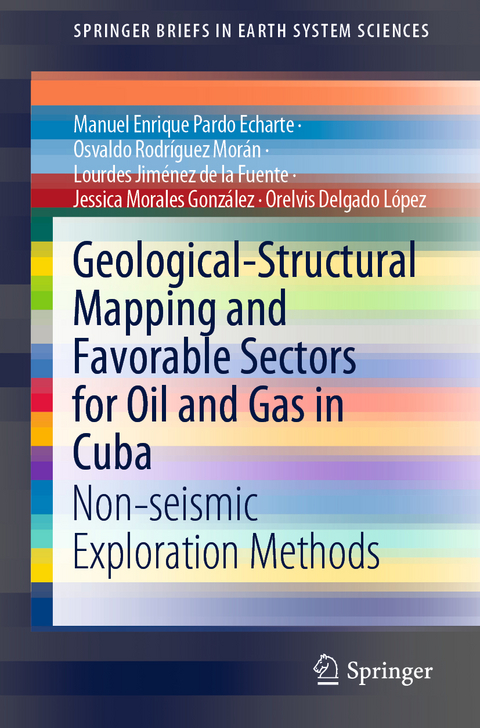
Geological-Structural Mapping and Favorable Sectors for Oil and Gas in Cuba
Non-seismic Exploration Methods
Seiten
2022
|
1st ed. 2022
Springer International Publishing (Verlag)
978-3-030-92974-9 (ISBN)
Springer International Publishing (Verlag)
978-3-030-92974-9 (ISBN)
The so-called "Non-conventional geophysical-geochemical exploration methods" are used, in the particular case of oil and gas exploration, for the detection and mapping of active microseepage of light hydrocarbons with a vertical nature on the gas-oil accumulations.
The non-seismic exploration methods used in Cuba are: Remote Sensing, Gravimetry, Aeromagnetometry, Airborne Gamma Spectrometry (AGS) and Morphometry (non-conventional, from the Digital Elevation Model 90x90m). The AGS also classifies, as a non-conventional geophysical-geochemical method, together with the Redox Complex.
Besides, it is of interest to know the geological-structural framework where these microseepage occur. That is why the benefits of using these methods (excluding Redox Complex), prior to their integration with geological and seismic data, translate into a first approximation, valid for an initial understanding of geology and mapping of favourable areas of possible gas-oil interest.
Finally, from the implementation of these methods (including Redox Complex), perspective sectors for oil and gas are obtained, once the integration with geology and seismic has been carried out.
The book presents a brief theoretical account of the methods used and, as practical results, a set of perspective sectors of possible interest for exploration in Cuba.
As a complementary result, the book also offer an evaluation of the areas that meet the petroleum-geologist premises for the presence of large accumulations of high quality oil in Cuba.
The non-seismic exploration methods used in Cuba are: Remote Sensing, Gravimetry, Aeromagnetometry, Airborne Gamma Spectrometry (AGS) and Morphometry (non-conventional, from the Digital Elevation Model 90x90m). The AGS also classifies, as a non-conventional geophysical-geochemical method, together with the Redox Complex.
Besides, it is of interest to know the geological-structural framework where these microseepage occur. That is why the benefits of using these methods (excluding Redox Complex), prior to their integration with geological and seismic data, translate into a first approximation, valid for an initial understanding of geology and mapping of favourable areas of possible gas-oil interest.
Finally, from the implementation of these methods (including Redox Complex), perspective sectors for oil and gas are obtained, once the integration with geology and seismic has been carried out.
The book presents a brief theoretical account of the methods used and, as practical results, a set of perspective sectors of possible interest for exploration in Cuba.
As a complementary result, the book also offer an evaluation of the areas that meet the petroleum-geologist premises for the presence of large accumulations of high quality oil in Cuba.
Chapter 1. Non-seismic and unconventional exploration methods for oil and gas in Cuba: perspective sectors.- Chapter 2. Geological-structural mapping and favorable sectors for oil and gas in Western Cuba through non-seismic exploration methods.- Chapter 3. Identification of hydrocarbon microseepage through remote sensors in the Majaguillar - Motembo sector, Cuba.- Chapter 4. Physical-geological modeling of potential fields in the northeastern zone of the Central Basin of Cuba.
| Erscheinungsdatum | 08.02.2022 |
|---|---|
| Reihe/Serie | SpringerBriefs in Earth System Sciences |
| Zusatzinfo | XXIX, 106 p. 63 illus., 61 illus. in color. |
| Verlagsort | Cham |
| Sprache | englisch |
| Maße | 155 x 235 mm |
| Gewicht | 221 g |
| Themenwelt | Naturwissenschaften ► Geowissenschaften ► Geologie |
| Schlagworte | Aeromagnetometry • airborne gamma spectrometry • Digital Elevation Model • Favorable and perspective sectors for hydrocarbons • geological-structural mapping • Gravimetry • Morphometry • Non-seismic methods of oil and gas exploration • Redox Complex • Remote Sensing |
| ISBN-10 | 3-030-92974-4 / 3030929744 |
| ISBN-13 | 978-3-030-92974-9 / 9783030929749 |
| Zustand | Neuware |
| Haben Sie eine Frage zum Produkt? |
Mehr entdecken
aus dem Bereich
aus dem Bereich


